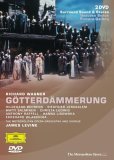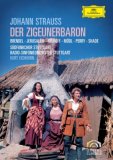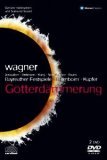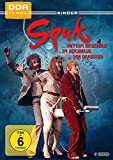 Die Walkure | DVD | (01/06/2005)
from £N/A
| Saving you £N/A (N/A%)
| RRP
Die Walkure | DVD | (01/06/2005)
from £N/A
| Saving you £N/A (N/A%)
| RRP The legendary production of Wagner's Der Ring des Nibelungen directed by Harry Kupfer at Bayreuth Festival Opera with designs by Hans Schavernoch and conducted by Daniel Barenboim is considered one of the greatest productions of this titanic work ever staged. For their innovative modernist staging Kupfer and his team turn away from the work's time of origin and located The Ring at a 'road of history' a meeting place of past present and future which sets the scene for the story'
 Wagner: Gotterdammerung -- Metropolitan/Levine | DVD | (14/10/2002)
from £12.24
| Saving you £11.01 (100.27%)
| RRP
Wagner: Gotterdammerung -- Metropolitan/Levine | DVD | (14/10/2002)
from £12.24
| Saving you £11.01 (100.27%)
| RRP Under the baton of James Levine, Gotterdammerung ("The Twilight of the Gods") has a narrative drive that reminds us that, of all the individual operas in Wagner's Ring cycle, this is the one most about human emotions and the one in which its heroes are pulled into a world where they are most vulnerable to them. Siegfried Jerusalem as Siegfried and Hildegard Behrens as Brunnhilde never, in a sense, stand a chance: they are innocents who allow themselves to be manipulated not merely by the villainous Hagen, but by the ordinary venality of Gunther and his sister Gutrune, who goes along with a dirty little scheme to get what she wants, and is destroyed by it. As the tempter figure Hagen, Matti Salminen dominates the stage whenever he is on it; he is one of those basses whose voice and scowl seem to come from somewhere deeper than his large boots: rarely have the summoning of the vassals, or the oath of vengeance he, Gunther and Brunnhilde swear against Siegfried seemed so utterly his triumph. Jerusalem is almost perfect as Siegfried in spite of the gravelly quality of his heroic tenor: he has a glorious innocence even when the character is tricked into desecrating his true love; Hildegard Behrens is magnificent as Brunnhilde, both in her anger at Siegfried's apparent betrayal of her and in her redemptive understanding of how she has to atone for his death. Other Gotterdammerungs may be more monumental, but few make you care so passionately. On the DVD: Gotterdammerung comes with menus and subtitles in German, French, English, Spanish and Chinese and with a picture gallery of the production. Awkwardly it is presented in (American) NTSC format, not PAL, and with a visual aspect of standard TV 4:3. More impressive is the choice of PCM stereo, Dolby Digital 5.1 or DTS 5.1; the sound is admirably clear and well-balanced. --Roz Kaveney
![The World At War - Vol. 2 [1973]](/pictures/1004348.jpg) The World At War - Vol. 2 | DVD | (28/08/2000)
from £12.99
| Saving you £12.00 (92.38%)
| RRP
The World At War - Vol. 2 | DVD | (28/08/2000)
from £12.99
| Saving you £12.00 (92.38%)
| RRP When this epic series was first broadcast in 1973 it redefined the gold standard for television documentary; it remains the benchmark by which all factual programming must judge itself. Originally shown as 26 one-hour programmes, The World at War set out to tell the story of the Second World War through the testimony of key participants. The result is a unique and unrepeatable event, since many of the eyewitnesses captured on film did not have long left to live. Each hour-long programme is carefully structured to focus on a key theme or campaign, from the rise of Nazi Germany to Hitler's downfall and the onset of the Cold War. There are no academic "talking heads" here to spell out an official version of history; the narration, delivered with wonderful gravitas by Sir Laurence Olivier, is kept to a minimum. The show's great coup was to allow the participants to speak for themselves. Painstaking research in the archives of the Imperial War Museum also unearthed a vast quantity of newsreel footage, including on occasion the cameraman's original raw rushes which present an unvarnished and never-before-seen picture of important events. Carl Davis' portentous main title theme and score underlines the grand scale of the enterprise. The original 26 episodes were supplemented three years later by six special programmes (narrated by Eric Porter), bringing the total running-time to a truly epic 32 hours. Now digitally remastered The World at War looks even more of an impressive achievement on DVD. Available in five volumes, each handsomely packaged double-disc set comes with a detailed menu that places the individual programmes along a chronological timeline. Better yet, chapter access is laid out to allow you to select key speeches or maps or newsreel footage. The World at War was a landmark television event; its DVD incarnation underlines its importance as an historical document. --Mark Walker
 Strauss - Der Zigeunerbaron | DVD | (12/05/2008)
from £N/A
| Saving you £N/A (N/A%)
| RRP
Strauss - Der Zigeunerbaron | DVD | (12/05/2008)
from £N/A
| Saving you £N/A (N/A%)
| RRP Johann Strauss - Der Zigeunerbaron.
![Wagner-Tristan and Isolde Bayreuth Festival [1995]](/pictures/1086561.jpg) Wagner-Tristan and Isolde Bayreuth Festival | DVD | (14/07/2008)
from £N/A
| Saving you £N/A (N/A%)
| RRP
Wagner-Tristan and Isolde Bayreuth Festival | DVD | (14/07/2008)
from £N/A
| Saving you £N/A (N/A%)
| RRP Wagner: Tristan And Isolde
![The World At War - Vol. 4 [1973]](/pictures/1004318.jpg) The World At War - Vol. 4 | DVD | (09/10/2000)
from £4.91
| Saving you £20.08 (408.96%)
| RRP
The World At War - Vol. 4 | DVD | (09/10/2000)
from £4.91
| Saving you £20.08 (408.96%)
| RRP When this epic series was first broadcast in 1973 it redefined the gold standard for television documentary; it remains the benchmark by which all factual programming must judge itself. Originally shown as 26 one-hour programmes, The World at War set out to tell the story of the Second World War through the testimony of key participants. The result is a unique and unrepeatable event, since many of the eyewitnesses captured on film did not have long left to live. Each hour-long programme is carefully structured to focus on a key theme or campaign, from the rise of Nazi Germany to Hitler's downfall and the onset of the Cold War. There are no academic "talking heads" here to spell out an official version of history; the narration, delivered with wonderful gravitas by Sir Laurence Olivier, is kept to a minimum. The show's great coup was to allow the participants to speak for themselves. Painstaking research in the archives of the Imperial War Museum also unearthed a vast quantity of newsreel footage, including on occasion the cameraman's original raw rushes which present an unvarnished and never-before-seen picture of important events. Carl Davis' portentous main title theme and score underlines the grand scale of the enterprise. The original 26 episodes were supplemented three years later by six special programmes (narrated by Eric Porter), bringing the total running-time to a truly epic 32 hours. Now digitally remastered The World at War looks even more of an impressive achievement on DVD. Available in five volumes, each handsomely packaged double-disc set comes with a detailed menu that places the individual programmes along a chronological timeline. Better yet, chapter access is laid out to allow you to select key speeches or maps or newsreel footage. The World at War was a landmark television event; its DVD incarnation underlines its importance as an historical document. --Mark Walker
![The World At War - Special Collectors Edition [1973]](/pictures/1002284.jpg) The World At War - Special Collectors Edition | DVD | (05/03/2001)
from £N/A
| Saving you £N/A (N/A%)
| RRP
The World At War - Special Collectors Edition | DVD | (05/03/2001)
from £N/A
| Saving you £N/A (N/A%)
| RRP When this epic series was first broadcast in 1973 it redefined the gold standard for television documentary; it remains the benchmark by which all factual programming must judge itself. Originally shown as 26 one-hour programmes, The World at War set out to tell the story of the Second World War through the testimony of key participants. The result is a unique and unrepeatable event, since many of the eyewitnesses captured on film did not have long left to live. Each hour-long programme is carefully structured to focus on a key theme or campaign, from the rise of Nazi Germany to Hitler's downfall and the onset of the Cold War. There are no academic "talking heads" here to spell out an official version of history; the narration, delivered with wonderful gravitas by Sir Laurence Olivier, is kept to a minimum. The show's great coup was to allow the participants to speak for themselves. Painstaking research in the archives of the Imperial War Museum also unearthed a vast quantity of newsreel footage, including on occasion the cameraman's original raw rushes which present an unvarnished and never-before-seen picture of important events. Carl Davis' portentous main title theme and score underlines the grand scale of the enterprise. The original 26 episodes were supplemented three years later by six special programmes (narrated by Eric Porter), bringing the total running-time to a truly epic 32 hours.Now digitally remastered The World at War looks even more of an impressive achievement on DVD. Each disc set comes with a detailed menu that places the individual programmes along a chronological timeline. Better yet, chapter access is laid out to allow you to select key speeches or maps or newsreel footage. The World at War was a landmark television event; its DVD incarnation underlines its importance as an historical document. --Mark Walker
 Wagner - Die Gotterdammer | DVD | (25/09/2006)
from £N/A
| Saving you £N/A (N/A%)
| RRP
Wagner - Die Gotterdammer | DVD | (25/09/2006)
from £N/A
| Saving you £N/A (N/A%)
| RRP Bayreuth Festspielhaus / Daniel Barenboim: Gotterdammerung
![Contamination [DVD]](/pictures/1144115.jpg) Contamination | DVD | (03/07/2017)
from £10.75
| Saving you £N/A (N/A%)
| RRP
Contamination | DVD | (03/07/2017)
from £10.75
| Saving you £N/A (N/A%)
| RRP Branded as a video nasty in the UK, director Luigi Cozzi s Contamination takes the premise of Ridley Scott s classic Alien and peppers it with exploding guts galore and a dangerously infectious soundtrack from celebrated Italian prog-rockers Goblin (Deep Red, Suspiria). A cargo ship drifts up the Hudson River. Its crew: all dead, their bodies horribly mutilated, turned inside out by an unknown force. Its freight: boxes upon boxes of glowing, pulsating green eggs. It soon becomes clear that these eggs are not of this planet, and someone intends to cultivate them here on Earth. But who? And to what end? Starring Italian horror veteran Ian McCulloch (Zombie Flesh Eaters), Contamination is an ultra-violent sci-fi epic that really gets under the skin. In space, no one can hear you scream but on Earth, the terror rings loud and clear!
![The Devil Came From Akasava [1970]](/pictures/1018167.jpg) The Devil Came From Akasava | DVD | (08/09/2008)
from £N/A
| Saving you £N/A (N/A%)
| RRP
The Devil Came From Akasava | DVD | (08/09/2008)
from £N/A
| Saving you £N/A (N/A%)
| RRP A new mineral is discovered which can turn metal to gold or humans into zombies. When the mineral is stolen secret agents are despatched to get it back!
![Contamination [1980]](/pictures/1021725.jpg) Contamination | DVD | (26/07/2004)
from £N/A
| Saving you £N/A (N/A%)
| RRP
Contamination | DVD | (26/07/2004)
from £N/A
| Saving you £N/A (N/A%)
| RRP When a deserted ship arrives in New York City carrying a slaughtered crew and an even more horrific cargo mutant green eggs the size of footballs that pulsate with life until they spray hideous chest-bursting death a government research team uncovers a grisly conspiracy of murder space monsters and coffee. Who is harvesting these alien hell-spores and what is their connection to a doomed mission to Mars? Directed by Luigi Cozzi owner and operator of the Dario Argento store in R
![Silent Night, Holy Night [1990]](/pictures/1028053.jpg) Silent Night, Holy Night | DVD | (22/10/2004)
from £5.84
| Saving you £10.41 (227.29%)
| RRP
Silent Night, Holy Night | DVD | (22/10/2004)
from £5.84
| Saving you £10.41 (227.29%)
| RRP Silent Night Holy Night From the Schauspielhaus Berlin1. Macht Hoch die Tur2. Es ist ein Ros' entsprungen3. Ave Maria4. Jubilate Domino5. Cantique de Noel6. In dulci jubilo7. Herrscher des Himmels (choir from the Christmas Oratorio)8. Russian Orthodox Hymns and Prayers9. Air (from the Orchestral Suite No. 3 in D major)10. Bereite dich Zion (Aria from the Christmas Oratorio)11. Concerto in B flat Minor for Harp and Orchestra12. Ombra mai fu (Aria from Xerxes)13. O Jesulein sub14. Joseph Iieber Joseph mein15. Tochter Zion Freue dich16. Stille Nacht heilige Nacht
![Wagner: Das Rheingold [1980]](/pictures/1012996.jpg) Wagner: Das Rheingold | DVD | (15/10/2001)
from £4.04
| Saving you £22.21 (798.92%)
| RRP
Wagner: Das Rheingold | DVD | (15/10/2001)
from £4.04
| Saving you £22.21 (798.92%)
| RRP ![The Cape Town Affair [1967]](/pictures/1053409.jpg) The Cape Town Affair | DVD | (21/06/2004)
from £5.99
| Saving you £-2.00 (N/A%)
| RRP
The Cape Town Affair | DVD | (21/06/2004)
from £5.99
| Saving you £-2.00 (N/A%)
| RRP  Berlin Schoenhauser Corner | DVD | (12/02/2007)
from £N/A
| Saving you £N/A (N/A%)
| RRP
Berlin Schoenhauser Corner | DVD | (12/02/2007)
from £N/A
| Saving you £N/A (N/A%)
| RRP This classic 1950s teen cult film neo-realist in style is a perceptive social portrayal of a city in which political and economic division have affected the entire population. Although the film became a box-office hit it was greeted with suspicion by GDR cultural officials. Director Gerhard Klein and screenwriter Wolfgang Kohlhaase were reproached for emphasizing 'negative problematic images of our [East German] life.' Despite the negative reception from GDR officials this film was loved by the public precisely for its truthful portrayal of everyday life. Ranked by film critics among Germany's 100 most important films this and other 'Berlin films' by director Klein and screenwriter Kohlhaase made an important contribution to the international youth film genre.
![Archie Shepp - The Archie Shepp Quartet - Part 2 [1977]](/pictures/1024255.jpg) Archie Shepp - The Archie Shepp Quartet - Part 2 | DVD | (18/02/2005)
from £26.98
| Saving you £-6.99 (N/A%)
| RRP
Archie Shepp - The Archie Shepp Quartet - Part 2 | DVD | (18/02/2005)
from £26.98
| Saving you £-6.99 (N/A%)
| RRP Archie Shepp was a popular topic of conversation among jazz fans during the 1970s as it was becoming increasingly clear that a profound change was taking place in his approach to music and even his physical appearance. For years he had been the embodiment of black resistance dressing in traditional African garments and protesting against the suppression of black people. But now he was wearing suits and had given up his free style of playing in favour of interpretations of well-kno
![Archie Shepp - The Archie Shepp Quartet - Part 1 [1977]](/pictures/1024418.jpg) Archie Shepp - The Archie Shepp Quartet - Part 1 | DVD | (22/12/2004)
from £N/A
| Saving you £N/A (N/A%)
| RRP
Archie Shepp - The Archie Shepp Quartet - Part 1 | DVD | (22/12/2004)
from £N/A
| Saving you £N/A (N/A%)
| RRP The Archie Shepp Quartet live atthe Teatro Alfieri in Turin in 1977. Tracklist: A Message From Trane Lush Life The Scene Is Clean
 St. Andrews Girls | DVD | (01/12/2009)
from £4.98
| Saving you £7.00 (234.11%)
| RRP
St. Andrews Girls | DVD | (01/12/2009)
from £4.98
| Saving you £7.00 (234.11%)
| RRP Four indomitable Catholic school girls face killer nuns gangsta Jews and giant lobsters!
 Spuk-Trilogie | DVD | (23/07/2021)
from £N/A
| Saving you £N/A (N/A%)
| RRP
Spuk-Trilogie | DVD | (23/07/2021)
from £N/A
| Saving you £N/A (N/A%)
| RRP 
Please wait. Loading...
This site uses cookies.
More details in our privacy policy